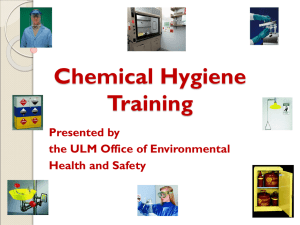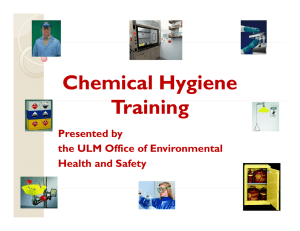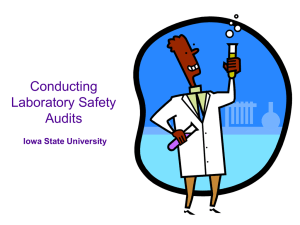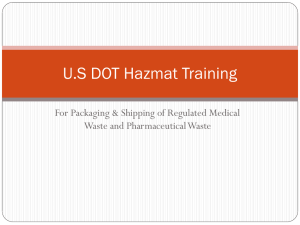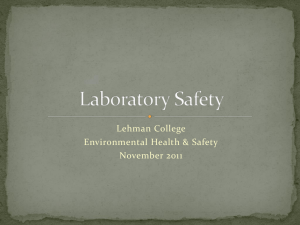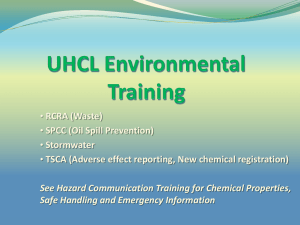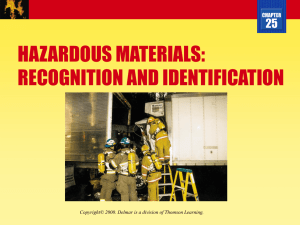LAB SAFETY
advertisement
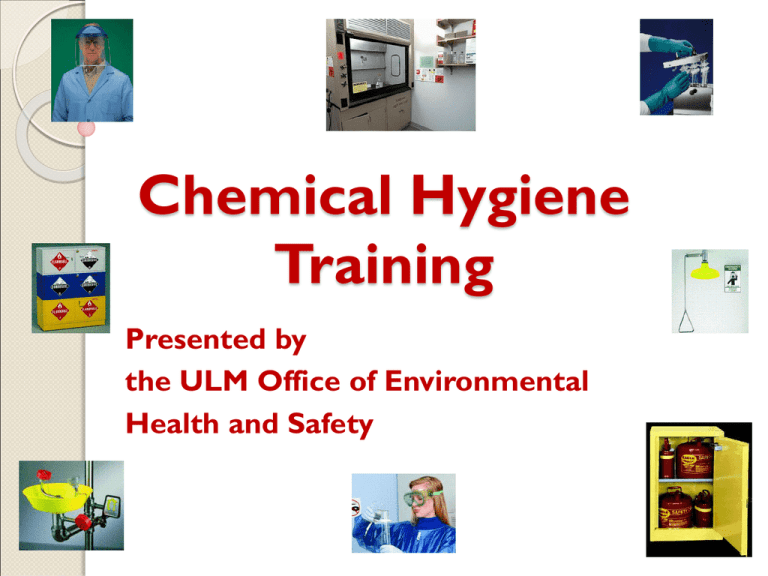
Chemical Hygiene Training Presented by the ULM Office of Environmental Health and Safety ULM Chemical Hygiene Plan Updated 2011 Scope Responsibilities Training Standard Operating Procedures Chemical Management Medical Consultation Chemical Hygiene Plan http://www.ulm.edu/safety/manual/hchemicalhygieneplan.htm The ULM Chemical Hygiene Plan applies to all ULM employees who work in teaching, research or clinical labs where hazardous materials are stored or used. Students are covered by the same ULM Chemical Hygiene Plan by University Policy. Responsibilities President, Vice Presidents, Deans, and Department Heads Maintain responsibility for financial, and planning support to assure resources are available to implement safety procedures in the labs. Environmental Safety Committee Composed of representatives of the faculty and staff who use or serve the labs. Reviews the Chemical Hygiene Plan as needed and assists in its implementation. Responsibilities Environmental Health and Safety Maintain the ULM Chemical Hygiene Plan Provide initial lab safety training Provide monitoring where chemical exposure is suspected or as required by regulation Inspect labs and chemical fume hoods at least annually Coordinate removal and proper disposal of hazardous waste Responsibilities Principle Investigator/Lab Supervisor Assure lab personnel comply with the CHP Create lab safety plans to supplement Train or arrange for training of lab workers Maintain training records Secure hazardous materials when not in use Correct deficiencies identified on inspection report and forward action plan to EH&S Assure all primary and secondary containers are properly labeled Maintain a current chemical inventory and forward a copy to EH&S at least annually Assure that engineering controls are functioning properly or tagged out of service Assure interim inspections are completed Responsibilities Principle Investigator/Lab Supervisor Arrange for monitoring when required by a specific standard, exposure is anticipated or suspected Arrange for medical surveillance where required through EH&S Determine lab specific Personal Protective Equipment needs, document on lab safety plan and forward to EH&S Provide necessary Personal Protective Equipment (PPE)at no charge to employees Submit all grants involving the use of hazardous chemicals to EH&S for review Post designated use areas for any carcinogen, reproductive toxin or acutely toxic chemical used in the lab Responsibilities Principle Investigator/Lab Supervisor Ensure the availability of a MSDS for each chemical listed on the lab chemical inventory Dispose of chemical waste properly through the ULM hazardous waste disposal system Initiate medical services and follow-up of any exposure incident in the lab through EH&S Post and maintain a current emergency information near the phone and on the door of the lab Complete lab close-out process when leaving the University and schedule final inspection with EH&S Include chemical hygiene and lab safety compliance in employee annual work plans for performance review Assure lab personnel comply with safety procedures Responsibilities Lab User Read and follow the guidelines in the Chemical Hygiene Plan and your Lab Safety Plans Participate in initial and refresher training Do not remove or deface labels on chemical containers Immediately label secondary containers Report accidents or hazardous conditions to your Lab Supervisor Request training when unsure about a procedure or material Use the resources available to access chemical information Perform only authorized work, preparations and experiments in the lab Training Chemical Hygiene/Lab Safety Training is required for each new individual before beginning work in the lab. Must be repeated every 3 years. Laboratory Specific Training Provided by lab supervisor Includes content of lab safety plans Document and keep on file for review Types Of Hazards CHEMICAL HAZARDS - flammables, corrosives, PHYSICAL HAZARDS - fires, explosions, noise RADIATION AND BIOLOGICAL SAFETY – poisons, explosives, reactives addressed by Prospective Health EMPLOYEE HEALTH – Prospective Health ANIMAL HANDLING – Comparative Medicine Effects Of Exposure ACUTE - direct threat that shows up CHRONIC - usually result from almost immediately after exposure such as burns from contact with a corrosive chemical repeated exposure that occurs over months or years and includes cancer and some allergic reactions Routes Of Exposure INHALATION ABSORPTION INGESTION INJECTION The most likely target depends upon the characteristics of the material being used. ROUTES OF EXPOSURE INHALATION Primary Route of Entry Airborne contaminants such as gases, vapors and particulate matter that enter directly into lungs. Chemical fume hood is the primary control available. Respiratory protection or specialized exhaust may be necessary where a fume hood cannot be used. ROUTES OF EXPOSURE ABSORPTION Can occur very quickly through cuts or abrasions on the skin. Depending on the characteristics of the contaminant, absorption may occur through intact skin (example: phenol) Mucous membranes and eye tissue are particularly vulnerable Barrier protection (such as gloves) and personal hygiene are the primary control measures. ROUTES OF EXPOSURE INGESTION Includes direct tasting of chemicals. More often occurs when contaminated items are placed in the mouth. Purpose for banning food, drink, tobacco, and cosmetics in the lab. Personal hygiene, labeling and housekeeping are very important to ingestion hazard control. ROUTES OF EXPOSURE INJECTION Includes all puncture wounds. Examples: needle sticks, glass shards or capillary tubes puncturing skin Difficult to protect against Use carefully planned procedures and personal diligence, including needle blocks. Standard Operating Procedures Personal Protection Laboratory Practice Personal Safety Laboratory Controls Lab Specific Information Should Be Identified in Lab Safety Plans Available on EH&S website Eye Protection All lab users, including visitors, must wear ANSI approved eye protection when potential exists for eye injury Contacts may be worn in the lab under appropriate eye protection Face shields and/or standing guards must be available for face or neck protection. Face shields do not replace the need for eye protection Protective Clothing Closed toed shoes of non-woven material with non-slip soles Clothing that covers arms and legs, NO SHORTS Lab coats with closed fasteners Non-flammable, non-porous aprons when using corrosives Remove before leaving the lab Launder separately Gloves Compatible with materials used Remove gloves and wash hands before leaving Inspect before use Clean or discard immediately after use Do not use latex gloves for chemical protection Personal Hygiene No Food or Beverages No Smoking Do Not Apply Cosmetics Do Not Consume Lab Ice or Deionized Water Wash Hands/Arms Before Leaving Lab Never Pipette by Mouth Do Not Smell or Taste Chemicals Constrain Long Hair/Loose Clothing Transporting Chemicals Cap All Containers Tightly Sealed, Inside Secondary Containment Use Freight Elevator Do not remove chemical containers from University buildings Ground Metal Containers When Dispensing Flammable Liquids Chemical Labels Maintain Labels on Incoming Containers Replace Torn or Defaced Labels Label Secondary Containers Immediately Label Content Name of Hazardous Chemical Hazard Warning Name of Responsible Party Date of Preparation Chemical Storage Minimize Storage Discard Chemicals Not Used in Past 3 Years or Not Identified for Future Procedures Store Chemicals in Compatible Groups Be Aware of Materials with Shelf Life Separate Groups with Barriers Flammables Cabinets >10 Gal. Closed Cabinets or ¾ “Lip” Corrosives Below Eye Level Inspect Containers and Labels Weekly Housekeeping Keep Chemical Use Areas (Countertops) Free From Contamination Close/Cap All Containers Not in Use Clean Drips and Spillage Off of Container Exterior Maintain the Minimum on the Work Surface Maintain Clear Working Aisles Maintain Clear Access to Fire Extinguishers, Safety Showers and Eyewashes Label Doors that Are Blocked Keep Storage Off of the Floor and Out of the Halls Compressed Gas Cylinders Installed and Leak Tested by Trained Personnel Secured in an Upright Position with 2 chains Capped When Not In Use Use Compatible Regulator and Auxiliary Equipment Fully Labeled with Content and Status Laboratory Access Public access is prohibited to visitors and nonuniversity personnel. Lock lab doors when unoccupied Lab staff who are or might be pregnant should consult their personal physician and provide them with a copy of their lab’s chemical inventory and lab safety plans Administrative, clerical and other non-lab personnel may not maintain workstations in a lab Personal Safety Do not remove lab equipment and chemical containers No horseplay Don’t work alone without supervisor’s permission and a safety plan Unattended operations require ◦ ◦ ◦ ◦ Permission Fail-safe Plan Emergency Instructions Lights On Eyewash and Safety Showers Must Meet ANSI Requirements 15 Minutes of Clear, Running Water Operate Eyewash Weekly If Used Seek Medical Attention Maintain Clear Access Fire Extinguishers Only Trained Individuals May Use PASS Method: Pull, Aim, Squeeze, Sweep All Uses Must Be Reported to Facilities Services Inspected Monthly by Facilities Services Chemical Purchase Choose the Least Hazardous Purchase the Smallest Quantity Ventilation Do Not Block Air Supply or Return Grills Do Not Remove Ceiling Tiles Do Not Store Chemicals in Chemical Fume Vent Hoods Use Toxic or Odorous Chemicals in Fume Hoods Chemical Fume Hood Use For All Operations Where Odoriferous,Volatile, Toxic or Harmful Release Possible Assure Hood is Properly Functioning Reduce Turbulence: Work at least 6 inches into the hood Elevate Large Apparatus 2 inches Maintain Sash Height At or Below Posted Level Do Not Use the Hood for Storage Annual Hood Testing EH&S Tests Chemical Hoods New Installations Must Be Reviewed by EH&S Ductless or Recirculating Fume Hoods are PROHIBITED Hood Testing Pass Hoods are tested with dry ice & face velocity is measured Fail Fail A sticker will be placed indicating maximum sash height A tell tale will be attached to the hood Hoods that do not pass will be posted out of service The Rulers Of The Hazardous Waste Management World EPA (Environmental Protection Agency): Identification, storage, & disposal of hazardous waste under RCRA (Resource Conservation & Recovery Act). DOT (Department of Transportation): Identification, packaging, and transportation of hazardous material. Chemical Waste Management “Hazardous Material” is any liquid, solid, or gas having properties requiring special handling due to hazardous chemical characteristics. “Hazardous waste” is a used or discarded hazardous material. “Discarded” includes abandoned, recycled, or inherently waste-like materials. You Might Have A Hazardous Waste If …. The compound or solution is: - Ignitable - Corrosive - Reactive - Toxic What Is An Ignitable Waste? It is a liquid and is capable of burning or causing a fire. This material will have a flash point below 140o F. Examples include acetone, gasoline, industrial alcohols. What Is A Corrosive Waste? The material is a liquid or solid and is capable of eroding materials and human tissue. These materials have a pH of 2 or less or 12.5 or greater Examples: Alkaline cleaners, some chlorides, fluorides, and acids & bases. What Is A Reactive Waste? Waste that is: capable of reacting dangerously with air and water When mixed with water could cause an explosion Could release poisonous fumes, is shock sensitive. Examples include peroxides, isocynates, cyanides, sulfides, and chlorine. What Is A Toxic Waste? Material is capable of poisoning humans. Contains arsenic, barium, cadmium, chromium, lead, mercury, selenium, or silver Contains a pesticide or other EPA toxin Wastes are determined to be “Toxic” if they fail the TCLP Test. Waste Mixtures Keep non-solubles separate. Keep chlorinated solvents separate from non. Precipitate dissolved solids and filter. Minimize water in solvents. Teach waste minimization as part of lab instruction. Remember … you pay for chemicals twice. ◦ 14 gallon lab pack = $225 or $16 per gallon ◦ 55 gallon bulk = $150 or $2.74 per gallon Waste Minimization Find a non-hazardous alternative. Practice Inventory Control: Use it all Recycle/Recover Reduce: final procedure Teach waste minimization as part of lab instruction The Four “L’s” of Satellite Accumulation Lids: Keep containers tightly closed. Open only when adding waste. containers Labels: Tag containers before using for collection. Leaks: Inspect waste containers weekly for leaks. Residue on outside of a container is considered a discharge by EPA. Keep containers clean. Location: Collect waste at or near point of accumulation in a secondary container. Segregate by compatibility. waste Hazardous Waste Labeling All Hazardous Waste containers must be properly labeled. DO NOT use chemical formulas or abbreviations. Tag must show all the constituents by percent. Attach the tag to the container with string, wire or rubber band. Inspect label integrity and replace if damaged or stained. Hazardous Waste Disposal Ensure that wastes are properly packaged and labeled. Request a pickup of hazardous waste from the ULM EHS Department at 342-5177. Provide your name, phone #, location, identity, and amounts of waste. Waste pick-ups are scheduled on an as needed basis. Drain Disposal - Not An Option In The Event Of A Spill If the spill represents an increased risk of exposure to you or others, GET HELP! Leave the area, close all doors and call for assistance if any of the following occur: A fire or potential for a fire - dial 1-911. Serious injury or a hazardous chemical exposure - dial 1-911. Beyond your ability to control - call EH&S (342-5177). The spill has left the immediate area or threatens others areas – call EH&S (342-5177) or 1-911. Unknown materials are involved – call EH&S (342-5177). Non-emergency calls may be directed to UPD at 342-5350 When Reporting A Spill… Call Environmental Health & Safety at 342-5177. If no on answers call University Police at 342-5350. State your NAME. Give your EXACT LOCATION (Building and room #). Explain the CHEMICAL SPILLED (type, concentration, and quantity). Describe any SPECIAL CIRCUMSTANCES that may be involved. Leave a PHONE NUMBER or SPECIFIC LOCATION where you can be reached. Stay safely nearby to meet EH&S/emergency personnel. Medical Surveillance When … Employee develops signs or symptoms associated with exposure Monitoring reveals an exposure level routinely above the Action Level or PEL There is an event (spill, leak, explosion, etc.) Required by a specific OSHA standard Access EMERGENCY OR AFTER HOURS – ULM Health Services (will direct to local hospital as necessary). After hours – please report to nearest emergency room. Non-emergency – Schedule treatment with ULM Health Services through EH&S Worker’s Compensation Manager (Human Resources) Routine Medical Surveillance - Schedule appointments through EH&S at 342-5177. Follow-Up All exposure incidents, regardless of where treatment was provided must be reported through EH&S and Worker’s Compensation Manager (Human Resources) using the appropriate forms: (http://www.ulm.edu/safety/manual/caccidentinvestigation.htm) All incidents in the lab must be investigated by the Lab Supervisor and/or EH&S to identify potential causes and possible corrective actions Required Documentation Documents required to be maintained in your laboratory and to be readily available for review during inspection may be located at the link below: http://www.ulm.edu/safety/manual/hchemicalhygieneplan.htm Lab Inspections All University labs – monthly by staff member designated by department head Inspection sheets are available on the EH&S web page: http://www.ulm.edu/safety/manual/hchemicalhygieneplan.htm Purpose of inspections is to assist departments: Compliance with EPA regulations Compliance with OSHA Lab Standard Compliance with ORM/FARA regulations Compliance with fire and life safety codes Provide required paper records for regulatory agency visit ADDITIONAL INFORMATION Environmental Health & Safety at 342-5177 or nugent@ulm.edu http://www.ulm.edu/safety/ Facilities at 342-5171 or roubique@ulm.edu University Police 342-5350 Human Resources 342-5140 ULM Health Services 342-1651
